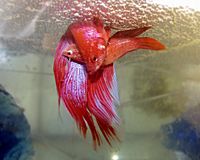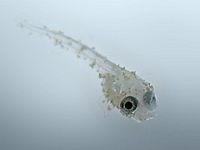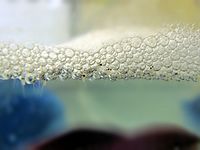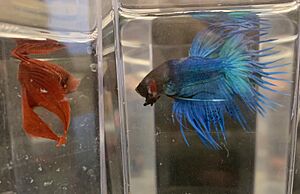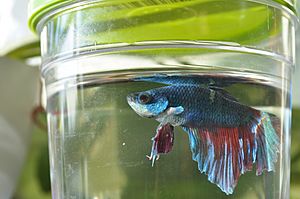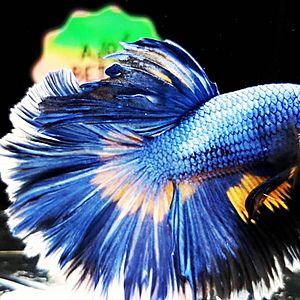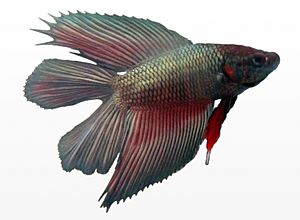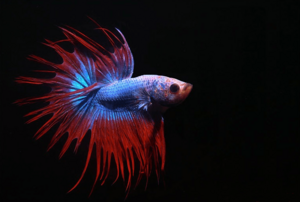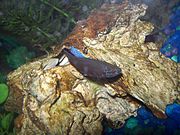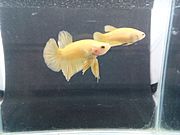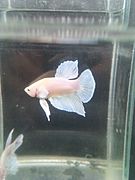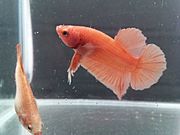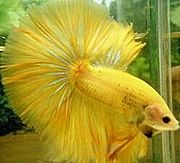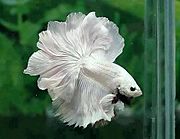Betta splendens facts for kids
Quick facts for kids Betta splendens |
|
|---|---|
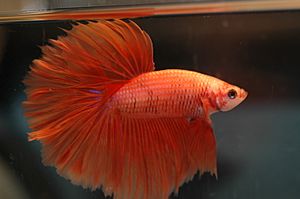 |
|
| Halfmoon male | |
| Conservation status | |
| Scientific classification |
The Siamese fighting fish (Betta splendens), often called the betta, is a freshwater fish. It comes from Southeast Asia, including Cambodia, Laos, Myanmar, Malaysia, Indonesia, Thailand, and Vietnam. It is one of 73 types of fish in the Betta group. People worldwide love bettas as pets. They are popular because they come in many colors and shapes. They are also quite easy to care for.
Siamese fighting fish first came from the central plains of Thailand. People started raising them there over 1,000 years ago. This makes them one of the oldest fish to be kept by humans. At first, they were bred for fighting. People would bet on these fights, much like cockfighting. Bettas became known outside Thailand thanks to King Rama III (1788–1851). He reportedly gave some to Theodore Cantor, a Danish scientist. These fish first arrived in Western countries in the late 1800s. They quickly became popular as beautiful aquarium fish. Because they have been bred for so long, B. splendens now comes in many different colors and fin shapes. This is why they are called the "designer fish of the aquatic world."
Bettas are known for being very protective of their space. Male bettas will often fight each other if kept in the same tank. If they cannot escape, one or both fish usually die. Female bettas can also fight if their space is too small. Bettas can live in water with low oxygen or poor quality. This is because they have a special organ called a labyrinth organ. This organ lets them breathe air from the surface of the water. This is a unique feature of fish in the Anabantoidei group.
The Siamese fighting fish is the national aquatic animal of Thailand. Thailand is still the main country that breeds and sells bettas for pets. Even though many bettas are kept as pets, B. splendens is listed as "vulnerable" in the wild. This means they are at risk of becoming endangered. This is due to more pollution and the destruction of their natural homes.
Contents
What's in a Name?
Outside Southeast Asia, the name "betta" usually means B. splendens. But scientifically, "betta" refers to a whole group of fish. This group includes B. splendens and at least 72 other species. To avoid confusion, it's better to call B. splendens by its scientific name or "Siamese fighting fish."
Many English speakers say "bay-tuh" for betta. This is like the second letter of the Greek alphabet. However, the name likely comes from the Malay words ikan betta. Ikan means "fish," and bettah refers to an old warrior tribe. This is pronounced "bet-tah." Other ideas suggest Betta splendens means "enduring fish" in Malay and "shining" in Latin.
Another common name for short-finned bettas is plakat. This comes from the Thai words pla kat (ปลากัด), meaning "biting fish." In Thailand, this name is used for all Betta fish. They all tend to be aggressive. So, "fighting fish" can mean any Betta species, not just the Siamese fighting fish.
Siamese fighting fish were first called Macropodus pugnax in 1849. This means "aggressive fish with big feet," probably because of their long pelvic fins. In 1897, they were put into the Betta group and called Betta pugnax. This name also pointed to their aggressive nature. In 1909, the fish was renamed Betta splendens. This happened when scientists found another fish already named pugnax.
Fish Features
B. splendens usually grows to about 6–8 centimeters (2.4–3.1 inches) long. Pet bettas are known for their bright colors and long, flowing fins. But in nature, B. splendens are usually green, brown, and gray. Their fins are short. Wild fish only show strong colors when they are upset. People have bred pet bettas to have many vibrant colors and different tail shapes.
Where Bettas Live
Betta splendens are native to Southeast Asia. This includes the northern Malay Peninsula, central and eastern Thailand, Cambodia, and southern Vietnam. They are also found in nearby parts of Sumatra. This is probably because humans moved them there.
Bettas usually live in shallow water with lots of plants. This includes marshes, floodplains, and paddy fields (rice fields). Rice farming was common in Southeast Asia. These fields made perfect homes for bettas. This is how humans found them and started keeping them. Shallow water and warm air make oxygen disappear quickly. This led bettas to develop their labyrinth organ. This organ lets them breathe air directly. Because of this, bettas can live in tougher places than other freshwater fish. This also means they have fewer natural enemies or other fish competing with them.
The weather where bettas live can change a lot. Water pH can be slightly acidic (pH 6.9) to very alkaline (pH 8.2). Air temperatures can drop to 15 °C (59 °F) and rise to 40 °C (100 °F). This makes Siamese fighting fish very tough and able to adapt. They can handle many harsh environments. This is why they are popular pets. It also explains why they can live in water bodies all over the world.
Wild bettas like to live in water full of plants. This includes floating leaves and water lilies. Many plants help them hide from predators. They also create boundaries between aggressive males. Males claim dense plant areas as their space. Plants also protect females when they lay eggs and young fish when they are tiny.
Bettas in New Places
Bettas are popular worldwide. This has led to them being released in other warm places. These include southeast Australia, Brazil, Colombia, the Dominican Republic, the southeast United States, and Singapore.
In January 2014, many bettas were found in the Adelaide River Floodplain in Northern Territory, Australia. As a new species there, they can harm local fish, frogs, and other wetland animals. Bettas have also settled in warmer parts of the United States, like southern Texas and Florida. However, a study by the U.S. Fish and Wildlife Service said they were not a threat to those natural areas.
Protecting Bettas in the Wild
Many Siamese fighting fish are kept as pets. But in the wild, their homes are in danger. Pollution from chemicals and farms harms their water. Also, human medicine from sewage systems can get into the water. This pollution can change how bettas reproduce. It can lower how many eggs hatch. It can also make fathers eat their own eggs. Wild bettas are also losing their homes because more palm oil farms are being built in Southeast Asia. The main threats are habitat loss and pollution. These are caused by cities and farms growing in central Thailand. The IUCN lists wild bettas as "vulnerable." This means they might become endangered if we don't help protect them.
What Bettas Eat
Betta splendens are naturally carnivores. They eat tiny water animals like zooplankton, small crustaceans, and insect larvae, such as mosquitoes. They also eat insects that fall into the water. Sometimes they eat algae. Some pet food ads might say bettas can live only on plants or roots. But this is not true.
You can feed bettas a mix of pellets, flakes, or frozen foods. Good frozen foods include brine shrimp, bloodworms, and daphnia. Bettas have short digestive systems, like most carnivores. This means they have trouble digesting carbohydrates like corn and wheat. These are often used as fillers in many fish foods. So, a good betta diet should mostly be animal protein.
It's easy to overfeed bettas. Too much food can make them fat or sick. It can also make the water dirty. It's best to feed a betta once a day. Give them only what they can eat in 3–5 minutes. Remove any food left over.
Some people suggest letting bettas "fast" for one day a week. This helps them fully digest their food. Bettas can go up to two weeks without eating. It's normal for them not to want to eat for a day or two. This often happens after stressful events, like a water change or moving to a new tank.
Reproduction and Life Cycle
If a male betta likes a female, he will spread his gills and fins. He will twist his body in a dance. Females who are ready to breed will get darker in color. They will also show vertical lines called "breeding bars." Males build bubble nests on the water's surface. These nests can be different sizes. Females who are interested might check out the nest. Males often build these nests even if no female is around.
Plants or rocks that stick out of the water often form a base for bubble nests. During courtship, the male betta might chase or nip at the female's fins. The actual mating is called a "nuptial embrace." The male wraps his body around the female. About 10–40 eggs are released each time. This continues until the female has no more eggs. As eggs are released, the male releases sperm into the water. Fertilization happens outside the body. During and after mating, the male uses his mouth to pick up sinking eggs. He places them in the bubble nest. Some females help, but often they just eat the eggs they catch. Once the female has laid all her eggs, the male chases her away. She will likely eat the eggs. If she is not removed from the tank, the male will probably kill her.
The male takes care of the eggs. He keeps them in his bubble nest. He makes sure none fall to the bottom. He also fixes the nest if needed. The eggs hatch in 24–36 hours. The tiny new fish stay in the nest for two to three more days. This is until they use up their yolk sacs (food supply). After that, the young fish leave the nest and start swimming freely. At this stage, young B. splendens rely only on their gills. The labyrinth organ, which lets them breathe air, usually grows when they are three to six weeks old. This depends on how fast they grow. B. splendens can become ready to breed as early as 4–5 months old. You can usually tell males from females around two months after they hatch. Young bettas can eat special fish food or live moving prey. Live food like baby brine shrimp, water fleas, and mosquito larvae are often preferred. Boiled egg yolks are sometimes fed to young fish, but bettas don't usually like them.
History of Bettas
We don't know exactly when Siamese fighting fish were first kept as pets. We also don't know when they were brought out of Asia. Genetic studies suggest they were first kept by humans at least 1,000 years ago. Other DNA evidence hints that bettas might have been bred for fighting since the 1200s. Over time, this led to the many different types of bettas we see today.
Fighting Fish
People in Malaysia and Thailand were collecting wild bettas by the 1800s. They saw how aggressive these fish were. They started putting them against each other in gambling matches, like cockfights. In the wild, bettas fight for only a few minutes before one gives up. But pet bettas, especially Plakat bettas, are bred to be very aggressive. They can fight for much longer. The winner is the fish that keeps fighting. Once a fish gives up, the match ends. Fights to the death were rare. People bet on how brave the fish were, not if they would survive. Because pet bettas were bred for fighting, they are often more aggressive than wild bettas.
These fights became popular. The king of Siam (Thailand) even made rules and taxes for the matches. He also collected fighting fish himself. In 1840, he gave some of his best fish to a Danish doctor named Theodore Edward Cantor. Nine years later, Cantor wrote the first article about these fish. He named them Macropodus pugnax. In 1909, a British fish expert named Charles Tate Regan found that another fish was already named Macropodus pugnax. So, he renamed the pet Siamese fighting fish Betta splendens, meaning "splendid fighter."
Bettas as Pets
Betta splendens first came to Western aquariums in the late 1800s. The earliest known arrival was in 1874 in France. A French aquarium expert, Pierre Carbonnier, started importing and breeding them. In 1896, a German fish expert, Paul Matte, brought the first bettas to Germany from Moscow. These were likely from the fish Carbonnier had bred. This shows that bettas were already somewhat known in France and Russia by the early 1900s. Fighting fish were also in Australia by 1904. This is based on an article by a British zoologist, Edgar Ravenswood Waite. He said Australian bettas came from Penang, Malaysia, near Thailand. Bettas might have first come to the United States in 1910. They came through importers in California. There is also proof they were imported in 1927 from Cambodia.
We don't know exactly when bettas became popular as pets. But the early 1900s was when people started breeding bettas for beauty. Before this, they were bred for fighting. In 1927, an article in Germany described the long, flowing fins of the "veiltail" breed. This shows that looks were becoming important. In the 1950s, an American breeder made a bigger, longer-finned veiltail. Around 1960, Indian breeders found a genetic change that gave fish two tail fins. This created the "doubletail" variety. In the same decade, a German breeder made the "deltatail" with wider, triangle-shaped fins.
In 1967, a group of betta breeders formed the International Betta Congress (IBC). This was the first official group for Siamese fighting fish. The IBC wanted to breed healthier bettas with more even fins and body shapes. They also focused on the well-being of the fish.
Caring for Bettas in an Aquarium
Water Needs
Bettas are tropical fish. They like water temperatures around 24–28 °C (75–82 °F). But they can survive for a short time in extreme temperatures. These can be as low as 13 °C (56 °F) or as high as 35 °C (95 °F). If you live in a colder place, an aquarium heater is a good idea. Cold water weakens their immune system. This makes them more likely to get sick.
The pH of the water also affects bettas. A neutral pH of 7.0 is perfect. Slightly higher levels are okay. Because of their labyrinth organ, bettas can handle low oxygen. But they cannot live long in dirty tanks. Poor water quality makes all tropical fish more likely to get diseases. These include fin rot or losing scales. So, even though bettas can handle still water, a filter is needed for their long-term health. Live aquatic plants also help filter the water. They also make the tank more interesting for the betta.
Tank Size and Tank Mates
Bettas are often sold in small containers. But they do best in larger tanks. They can survive in cups or bowls. But they will be much happier, healthier, and live longer in a bigger aquarium. Some betta fans say there's a minimum tank size. But it's not a strict rule. Most people agree that the tank should be at least 19 liters (5 US gallons). A larger tank is often easier for new owners to keep clean.
Male bettas are lonely and aggressive towards each other. But they can usually live with many other types of fish and invertebrates. This is true if there is enough space and places to hide. However, how well they get along depends on the individual betta's personality. It's good to watch how your betta acts with other fish. Tank mates must be tropical, friendly, not protective of their space, and not look like a betta. Coldwater fish like goldfish need different temperatures. Aggressive fish might nip at the betta's fins. Fish that swim in groups, like tetras and danios, are often best. They usually keep to themselves. They can also handle the betta's protective nature because there are many of them. Avoid brightly colored fish with large fins, like male guppies. Male bettas might nip at their fins. It's usually best to add other fish before the male betta. This way, they can set up their own spaces first.
Female bettas are less aggressive than males. So, they can live with more types of fish. For example, brightly colored or large-finned fish usually won't bother a female. Females can also handle more tank mates than males. But like males, how well a female gets along with other fish depends on her personality.
It's not a good idea to keep male and female bettas together. Only do this for breeding, and always with care and supervision.
Setting Up the Tank
Bettas are quite smart and curious. They need things to keep them busy. Otherwise, they can get bored and sad. This can make them lazy and sick. Decorations like plastic or live plants, rocks, caves, and wood are important. They make the tank interesting. Just make sure they don't have rough or sharp edges. These can hurt their delicate fins. In the wild, Siamese fighting fish hide under floating plants or leaves. This helps them avoid predators. Floating plants and leaves can make bettas feel safer. They also give males a place to build their bubble nests. Lots of plants are generally good. They provide safety and let the betta claim its own space.
Indian almond leaves are becoming popular. They create a more natural environment for bettas. Their tannins are said to help the fish. They might treat problems like fin rot and bladder disease. They can also help keep the water's pH stable.
Health and Wellness
When cared for properly and fed well, Siamese fighting fish usually live three to five years as pets. Some rare cases live as long as seven to ten years. One study found that bettas in tanks of several gallons lived over nine years. They had good food and "exercise" (being chased by a stick for a short time). Bettas kept in small jars lived much shorter lives. A larger tank with a good filter, regular cleaning, and lots of decorations helps them live longer. A diet rich in protein also helps.
Like all pet tropical fish, bettas can get sick. This is usually from bacteria, fungi, or parasites. Most illnesses come from dirty or cold water. Both weaken their immune system. The four most common illnesses are white spot, velvet, fin rot, and dropsy. Dropsy is usually incurable. The others can be treated with fish medicine, warmer water, or regular water changes.
If bettas are in a tank with other fish, fin nipping can lead to fin rot. This can make it harder to know what's wrong.
Betta Varieties
Over a hundred years of careful breeding has created many different colors and fin types. Breeders around the world keep making new ones. Often, male bettas are sold more because they are more beautiful than females. Females almost never have fins or colors as showy as males. But some breeders have created females with pretty long fins and bright colors.
Betta splendens can breed with B. imbellis, B. mahachaiensis, and B. smaragdina. But when bred with B. smaragdina, the young fish often don't survive. Betta splendens has also been bred with Macropodus opercularis, the paradise fish.
Colors
Wild bettas only show strong colors when they are upset. Over centuries, breeders have made these colors permanent. Many colors now breed true, meaning they pass down reliably. Pet bettas come in red, orange, yellow, blue, steel blue, turquoise/green, black, pastel, opaque white, and many colors mixed. Recent studies suggest blue males might be more aggressive than red males. On the other hand, female bettas might prefer red males.
Bettas have many colors because of different layers of pigmentation in their skin. From the deepest layer to the outside, these are red, yellow, black, iridescent (blue and green), and metallic. Metallic isn't a color itself, but it reacts with other colors. Any mix of these layers can be present. This leads to a huge variety of colors.
The shades of blue, turquoise, and green look a bit shimmering. They can seem to change color in different light or from different angles. This is because these colors are not from pigments. They are created by light bending within a layer of clear guanine crystals. Breeders have also made different color patterns like marble and butterfly. They also created metallic shades like copper, gold, or platinum. These were made by breeding B. splendens with other Betta species.
Some bettas change colors during their lives. This is called marbling. It happens because of a transposon. This is a DNA part that can move around. This changes the cell. Koi bettas have changed over time. Some change colors or patterns throughout their lives (called true Koi). This is because a faulty gene that causes marbling is not fixed in the color layers.
Common colors:
- Super Red
- Super Blue
- Super Yellow
- Opaque
- Super Black
- Super White
- Orange
- Marble
- Candy
- Nemo
- Galaxy Nemo
- Koi
- Alien
- Copper
- Cellophane
- Gold
- Galaxy Koi
Rarer colors:
- Super Orange
- Metallic
- Turquoise
- Lavender
- Mustard Gas
- Grizzle
- Green
- Purple
Color patterns:
- Solid – The whole fish is one color.
- Bi-color – Fins are a different color than the body.
- Cambodian – Body is pale, almost clear, and fins are one solid color.
- Butterfly – Fins have clear bands of colors.
- Marble – Irregular patterns all over the body and fins.
- Piebald – Face is pale, flesh-colored, no matter the body color.
- Full Mask – Face is the same color as the body. Normally, the face is darker.
- Dragon – Strong base color with pale, shimmering scales on the main body.
- Multicolor – Three or more colors on the body that don't fit other patterns.
- Pastel – Light shade of color only on the fins. Body stays flesh-colored.
- Koi – Looks like carp from above. Patterns should be even with clear color lines.
- Nemo – Either white or orange based. Has three or four main colors: Orange, red, yellow, black.
Fin Shapes
Breeders have created many different fin and scale shapes:
- Veiltail – Long fins and a tail that is not even. The tail fin rays usually split only once. This is the most common tail type in pet stores.
- Crowntail – Fin rays are much longer than the membrane. The tail can look like a crown. Also called fringetail.
- Combtail – A shorter version of the crowntail. It comes from breeding a crowntail with another fin type.
- Halfmoon – A D-shaped tail fin that forms a 180° angle. The edges of the tail are sharp and straight.
- Over-Halfmoon or Super Delta Tail – Tail fin is wider than 180° (a side effect of trying to breed half-moons). This can sometimes cause problems because the fins are too big for the fish to swim well.
- Rosetail – So many fins that they overlap and look like a rose.
- Feather tail – Similar to the Rosetail, but looks rougher.
- Plakat – Short fins that look like those on wild bettas.
- Halfmoon plakat – A short-finned Halfmoon. It's a mix of plakat and halfmoon.
- Double tail or Full-moon – Tail fin is split into two parts. The dorsal fin is much longer. The two tails can be split differently.
- Delta tail – Tail spread is less than a Halfmoon (less than 180°).
- Super Delta (SD or SDT) – An improved Delta. Its tail spreads between 130-170 degrees, closer to a Halfmoon.
- Half-Sun – A Combtail with a tail fin that goes 180°, like a half-moon.
- Elephant Ear – Pectoral fins are much larger than normal, often white. They look like elephant ears.
- Spade Tail – Tail fin has a wide base that gets narrow to a small point.
Betta Behavior and Intelligence
Siamese fighting fish show complex behaviors. These can be different for each fish. Studies show they can learn new things. They can learn to react in a certain way after seeing new things. Because of these traits, scientists study bettas a lot.
Males and females will flare or puff out their gill covers. This makes them look bigger. They do this to scare other fish or to attract a mate. Flaring also happens when they are scared by movement or changes in their tank. In a tank, bettas might flare at their own reflection. They don't know it's themselves. Both male and female bettas show pale horizontal stripes if they are stressed or scared. But these color changes are rare in adult males because their colors are so bright. Females often flare at other females. This helps them decide who is in charge. Fish that are ready to mate show vertical stripes instead of horizontal ones.
Betta splendens like a tank with decorations. They try to claim their own space, even when alone. They might claim a plant or a rocky cave. They can become very protective of it. They will be aggressive towards other fish that enter their space. So, if you keep bettas with other fish, they need at least 45 liters (about 10 gallons). Many people think bettas cannot live with other fish. But they can live with many other types of aquarium fish. If the tank is set up right, bettas will only be aggressive towards fish that are smaller and slower than them, like guppies.
Bettas' aggression has led to people gambling on their fights. Two male fish are put against each other to fight. People bet on who will win. The fight involves nipping fins, flared gills, spread fins, and brighter colors. The fight continues until one fish gives up or tries to leave. One or both fish might die from injuries. But bettas rarely fight to the death. To avoid fights over space, male Siamese fighting fish are best kept apart. Males might even fight their own reflections. This is safer than fighting another male. But seeing their reflection for too long can stress some fish. Not all Siamese fighting fish react badly to other males. This is especially true if the tank is big enough for each fish to have its own space.
Female Aggression
Studies show that female bettas can also be aggressive, but less often and less strongly than males. One study watched a group of female Siamese fighting fish for two weeks. They saw them attacking, flaring, and biting food. This showed that when females live in small groups, they create a clear pecking order. For example, the top-ranked fish showed more displays of power. This research suggests that female Siamese fighting fish should be studied as much as males. They also have different behaviors.
Courtship Behavior
There has been a lot of research on how male and female Siamese fighting fish act when they are trying to mate. Studies often look at how aggressive males are during this time. For example, one study found that when males are building a bubble nest, they are not very aggressive towards females. This is because males are trying to attract females to their nest so they can lay eggs. It was also found that females often "listen in" on male fights to choose a mate. If a female sees males fighting, she is more likely to be attracted to the male who won. But if a female didn't see a fight, she won't prefer one male over another. As for the males, the "loser" is more likely to try to mate with a female who didn't "listen in." The "winner" didn't show a preference.
Another study looked at how male Siamese fighting fish change their mating behavior when another male is nearby. They put a fake female in the tank. The researchers thought males would hide their mating attempts from other males. Instead, when another male was present, the male was more likely to try to mate with the fake female. When there were no barriers, males were more likely to flare their gills at the other male. The researchers concluded that the male was trying to mate with the female and also communicate with his rival at the same time. These results show that many things can affect how male and female bettas act when they are trying to mate.
Energy Used in Fighting
Studies have found that Siamese fighting fish often start fights using a lot of energy. Then they slowly use less energy as the fight goes on. This means bettas start strong but then slow down. They don't want to waste too much energy if they won't win. Researchers also found that when two male Siamese fighting fish were kept together for three days, they fought most in the mornings of the first two days. But the fighting decreased as the day went on. The dominant male had more energy at first. But as the experiment continued, both fish had equal energy. Another study found that when two male bettas fought, their energy use was the same before and during the fight. However, the fish who won used more oxygen in the evening after the fight. This shows that fighting has long-lasting effects on a fish's energy use.
Effects of Chemicals on Behavior
Siamese fighting fish are good for studying how chemicals affect the brain and body. This is because their aggression comes from how their cells communicate and possibly from their genes.
One study looked at how testosterone affected female Siamese fighting fish. Females were given testosterone. This made their fins longer, their bodies more colorful, and their reproductive organs look like typical male fish. They became more aggressive when with other females. But they were less aggressive when with males. The researchers then let these females interact with a group of normal females. When the females stopped getting testosterone, those who had been with normal females still acted like males. But the females who were kept alone did not continue to act like males after the testosterone stopped.
Another study exposed male Siamese fighting fish to chemicals that disrupt hormones. The researchers wanted to know if this would affect how females reacted to these males. They showed females videos of the exposed males. The females preferred the males who were not exposed to the chemicals. They avoided the exposed males. The researchers concluded that these chemicals can hurt a male betta's chances of mating.
A psychology study used male Siamese fighting fish to study the effects of fluoxetine. This is a medicine used as an antidepressant in humans. Siamese fighting fish were chosen because they have similar brain pathways that control aggression. It was found that when exposed to fluoxetine, male Siamese fighting fish were less aggressive than usual. Research has also found that bettas react to serotonin, dopamine, and GABA.
Sleep Habits
Betta fish can have unusual sleep habits. New betta owners sometimes think their fish has died. In a tank, betta fish sleep anywhere they feel comfortable. This includes on the bottom, floating in the middle, or at the surface. Betta fish might sleep on their side, upside down, with their nose up, or with their tail up. They are also known to curl up or squeeze into tight spots, like behind a heater. One very unusual sleep habit is that they can sleep out of the water. They might rest on a leaf or any flat object sticking out of the water. This is possible because of their labyrinth organ. It works like a human lung, taking oxygen from the air instead of the water. When betta fish sleep, their bright colors often fade. This, combined with their strange sleeping positions, can make them look dead. Fish that hunt often avoid eating dead fish. This is because of the risk of getting diseases. So, this is a great way for bettas to protect themselves.
Betta Genetics
Even though bettas are very popular, we don't know much about their genes. We don't even fully understand how their sex is decided. A 2021 article said we need more scientific study into the Siamese fighting fish's genes. Here are some areas they thought were important:
- How the Betta group of fish is related. This includes if mouthbrooding (carrying eggs in the mouth) started once or many times.
- How much hidden diversity there is and what causes new species to form in the betta family.
- Which genes control parental care, aggression, color, and other betta traits.
- Ways to save betta genes to protect against losing different types of fish this century.
Bettas have also been used in studies to see how different pollutants, like oil, affect them. Knowing more about the betta's genes would help make these studies more accurate. Lastly, the betta fish is a great animal to study. Especially for aggression and color development. This is because they have very strong traits in these areas.
Right now, the full set of B. splendens chromosomes and mitochondrial genes have been mapped. Both sets of genes still need to be fully understood. But a plan for future work has been made. The mitochondrial genes for the peaceful betta, P. imbellis, have also been mapped. This could allow for useful comparisons between species in the future.
Fish Family Tree and Hidden Diversity
There are many species in the Betta group. Most of them look very similar. In Thailand alone, there are twelve named species. New species are found every 5–10 years. In the past, scientists tried to tell Betta species apart by how they looked. But since they look so similar, this method missed a lot of hidden diversity. Newer ways of identifying species use DNA barcoding. This compares a specific gene (the CO1 gene) from their mitochondrial genes. This has led to new ideas about how species are related. It also helps build new family trees for fish.
The fact that species look similar but are genetically different suggests that new species formed with hidden diversity in the Betta family. Current ideas about how new species formed consider the geography of their home in Thailand. They suggest that new species formed because groups were separated by barriers (allopatric) or lived in different areas next to each other (parapatric).
Genes and Betta Biology
Aggression
B. splendens are known for being very aggressive. This is because people have carefully bred them for many generations to be this way. Fighting types of B. splendens have been bred for aggression for over six centuries. This is due to the culture of fighting bettas and betting on the results. This has made them genetically different from their wild relatives. Fighting bettas have been shown to be much more aggressive than wild bettas. They also react differently to new places in terms of stress hormones.
The extreme aggression in fighting bettas, which is controlled by their genes, makes them great for studying the genetic basis of aggression. This is especially true since we can compare them to wild bettas.
Right now, using betta fish to study aggression is just starting. We don't know much about the genes that cause aggression in bettas. But different levels of aggression have been seen in different pet betta groups.
Color
Bettas are great for studying the genes behind color. This is because adult bettas have amazing color variations. Also, their developing embryos show visible color. It would also be very useful for the betta pet industry to be able to create a specific color. The price of a fish is mostly based on its color. Beautifully colored fish can be very expensive. One fish with the colors of the Thai flag sold for over $1,500.
We don't know much about the genes that create and control color in teleost fish in general. Bettas are no different. Most work in this area has been done on other animals, like zebrafish. But work done with other animals to find possible genes will be very helpful in finding the genes for color in bettas.
Research So Far
In 1990, scientists found genetic differences in four different color types of bettas. But these differences were small. Later experiments confirmed that there was genetic variation in bettas bred in Thailand. They had low numbers of different gene versions but high rates of mixing genes.
Notable color traits in B. splendens include the marbled look and the color-changing trait. The color-changing fish change color throughout their lives. While there are ideas about the genes behind these traits, there is little scientific proof.
Other Genetic Work
Some of the few genes found in bettas are related to the immune system. These were found in the first full genetic map of B. splendens. This map was made using advanced sequencing methods.
Breeding Facilities
Today, Southeast Asia leads the world in breeding and selling Siamese fighting fish. At first, male and female young fish are raised together in large tanks. But when males start to become aggressive (around 4–5 months old), they are separated. Males are then kept alone in small liquor flasks, about half a pint in size. Hundreds of these flasks might be packed closely together on the ground in a breeding facility. They are fed daily, usually with bloodworms. Each flask typically has a cut near the top. This lets water flow out for easy water changes. Females, meanwhile, might be kept in shared tanks until it's time to ship them. About 100,000 male bettas are shipped each week from Thailand to countries all over the world.
|
See Also
 In Spanish: Pez luchador siamés para niños
In Spanish: Pez luchador siamés para niños




